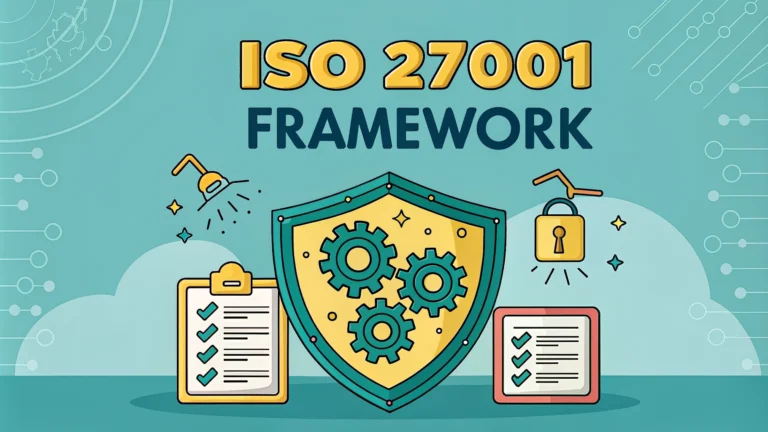Penetration testing forms a critical component of the ISO 27001 framework, serving as a practical method to evaluate an organization’s security controls and vulnerabilities.
Security teams use these controlled cyberattacks to identify weak points in systems, applications, and networks before malicious actors can exploit them.
This guide examines how penetration testing fits into ISO 27001 compliance and provides actionable steps for implementation.
Key Requirements for Penetration Testing in ISO 27001
- Regular testing schedules aligned with risk assessment results
- Documented methodology and scope for each test
- Qualified internal or external penetration testers
- Clear reporting and remediation procedures
- Integration with the Information Security Management System (ISMS)
Types of Penetration Tests Required
ISO 27001 recognizes several types of penetration tests that organizations should consider:
- Network Infrastructure Testing: Examines firewalls, routers, and network devices
- Web Application Testing: Focuses on web-based applications and services
- Wireless Network Testing: Evaluates Wi-Fi security and access points
- Social Engineering Tests: Assesses human-factor vulnerabilities
- Physical Security Testing: Reviews physical access controls and security measures
Implementation Steps
- Planning Phase
- Define scope and objectives
- Select testing methodology
- Assign resources and responsibilities
- Schedule testing windows
- Execution Phase
- Perform reconnaissance
- Identify vulnerabilities
- Exploit weaknesses
- Document findings
- Reporting Phase
- Generate detailed reports
- Prioritize vulnerabilities
- Provide remediation recommendations
Best Practices for ISO 27001 Penetration Testing
- Use both automated and manual testing methods
- Maintain detailed documentation of all testing activities
- Ensure proper authorization before beginning tests
- Follow ethical hacking principles
- Update testing procedures based on new threats
Common Tools and Resources
| Tool Category | Examples | Purpose |
|---|---|---|
| Vulnerability Scanners | Nessus, OpenVAS | Automated vulnerability detection |
| Network Analysis | Wireshark, Nmap | Network traffic analysis |
| Web Application Testing | OWASP ZAP, Burp Suite | Web application security assessment |
Reporting Requirements
ISO 27001 requires specific elements in penetration testing reports:
- Executive summary for management
- Technical findings with evidence
- Risk ratings for each vulnerability
- Clear remediation steps
- Timeline for fixes
Moving Forward with Security
Regular penetration testing helps organizations maintain ISO 27001 compliance while actively improving their security posture.
Contact certified ISO 27001 auditors or penetration testing firms through organizations like CREST (www.crest-approved.org) or ISC² (www.isc2.org) for professional assistance.
Maintaining Testing Effectiveness
- Review and update testing procedures annually
- Incorporate lessons learned from previous tests
- Monitor industry trends and emerging threats
- Adjust scope based on organizational changes
- Validate remediation efforts through retesting
Integration with Risk Management
- Align testing frequency with risk levels
- Use results to update risk registers
- Inform security investment decisions
- Support business continuity planning
- Enhance incident response capabilities
Documentation and Record Keeping
Essential records to maintain for ISO 27001 compliance:
- Test schedules and methodologies
- Tester qualifications and certifications
- Authorization documents
- Detailed test results and reports
- Remediation tracking logs
Strengthening Your Security Posture
Effective penetration testing within the ISO 27001 framework requires ongoing commitment and continuous improvement. Organizations should view testing as an integral part of their security strategy, not just a compliance requirement. Regular assessment, proper documentation, and swift remediation of findings help build a robust security foundation that protects assets and maintains stakeholder trust.
- Schedule regular testing cycles
- Invest in tester training and tools
- Keep stakeholders informed of progress
- Maintain detailed documentation
- Act promptly on test findings
FAQs
- What is the role of penetration testing in ISO 27001 compliance?
Penetration testing is a crucial component of ISO 27001’s control objectives, specifically under control A.12.6.1 (Technical Vulnerability Management), helping organizations identify and address security vulnerabilities before they can be exploited by malicious actors. - How often should penetration testing be conducted for ISO 27001 compliance?
ISO 27001 doesn’t specify a mandatory frequency, but organizations typically conduct penetration tests at least annually or after significant infrastructure changes, system upgrades, or modifications to security controls. - What areas should be covered in an ISO 27001 penetration test?
Testing should cover external and internal networks, web applications, mobile applications, wireless networks, and any critical systems within the Information Security Management System (ISMS) scope. - Who should perform penetration testing for ISO 27001?
Testing should be conducted by qualified security professionals, either internal or external, who possess relevant certifications and experience in penetration testing methodologies and ISO 27001 requirements. - What documentation is required for penetration testing under ISO 27001?
Organizations must maintain detailed reports of test results, methodologies used, vulnerabilities identified, risk assessments, and remediation plans as part of their ISMS documentation. - How do penetration test results affect ISO 27001 certification?
Critical vulnerabilities discovered during penetration testing must be addressed before certification can be achieved. Auditors will review testing reports and verify that appropriate remediation actions have been taken. - What types of penetration testing methods are acceptable for ISO 27001?
ISO 27001 accepts various testing methods including black box, white box, and gray box testing, as long as they align with the organization’s risk assessment and security objectives. - How should organizations handle penetration testing findings?
Findings must be risk-assessed, prioritized, and addressed through a documented remediation process. Actions taken should be verified and validated to ensure effectiveness. - What is the relationship between vulnerability scanning and penetration testing in ISO 27001?
While vulnerability scanning is automated and focuses on known vulnerabilities, penetration testing provides in-depth manual testing to identify complex security weaknesses. Both are required for comprehensive security assessment under ISO 27001. - How should organizations prepare for penetration testing under ISO 27001?
Organizations should define scope, objectives, and testing boundaries, obtain necessary approvals, prepare test environments, and ensure proper backup procedures are in place before testing begins.







